European foulbrood
Information about European foulbrood (Melissococcus plutonius), a serious brood disease of honey bees.
About European foulbrood
European foulbrood (EFB) is caused by a non-spore-forming bacterium, Melissococcus plutonius, and is a serious brood disease of honey bees. EFB infects the digestive track of honey bee larvae, with larvae younger than 3 days old being the most susceptible. As such, larvae found with EFB symptoms are typically still at the open cell stage or the stage before brood cells are capped. Once infected, most larvae die at 4 to 5 days old. While EFB does not affect adult honey bees, it can be easily spread by them.
EFB is often associated with poor nutrition or a lack of available forage for the colony. EFB is also thought to be problematic when colonies are under stress, such as during hive movement or poor weather conditions. EFB is highly contagious and the disease will contaminate beekeeping equipment, bees and honey, and will weaken, and in severe cases kill, a honey bee colony. While EFB is most commonly found in early spring, it may appear at any time of the year in honey bee colonies. Some antibiotics have been effective in the treatment of EFB. Beekeepers can take steps to mitigate an infection from establishing itself and manage an infection if present in their beekeeping operation.
EFB was prevalent several decades ago in Ontario, followed by a period when EFB was relatively rare and largely addressed through antibiotics. However, within the last decade EFB has re-emerged and is much more virulent in many regions of North America, including Ontario, and has resulted in the death of colonies in jurisdictions outside of Ontario. In general, pest and disease statuses change over time as they evolve and as such pests and diseases may become more or less common or more or less virulent. At present, EFB is considered a serious disease in Ontario that has increased in prevalence.
Transmission and life cycle
The disease begins with nurse bees picking up EFB from infected colonies or from brood food that is contaminated with the bacterium Melissococcus plutonius. Contaminated food is subsequently fed to developing honey bee brood.
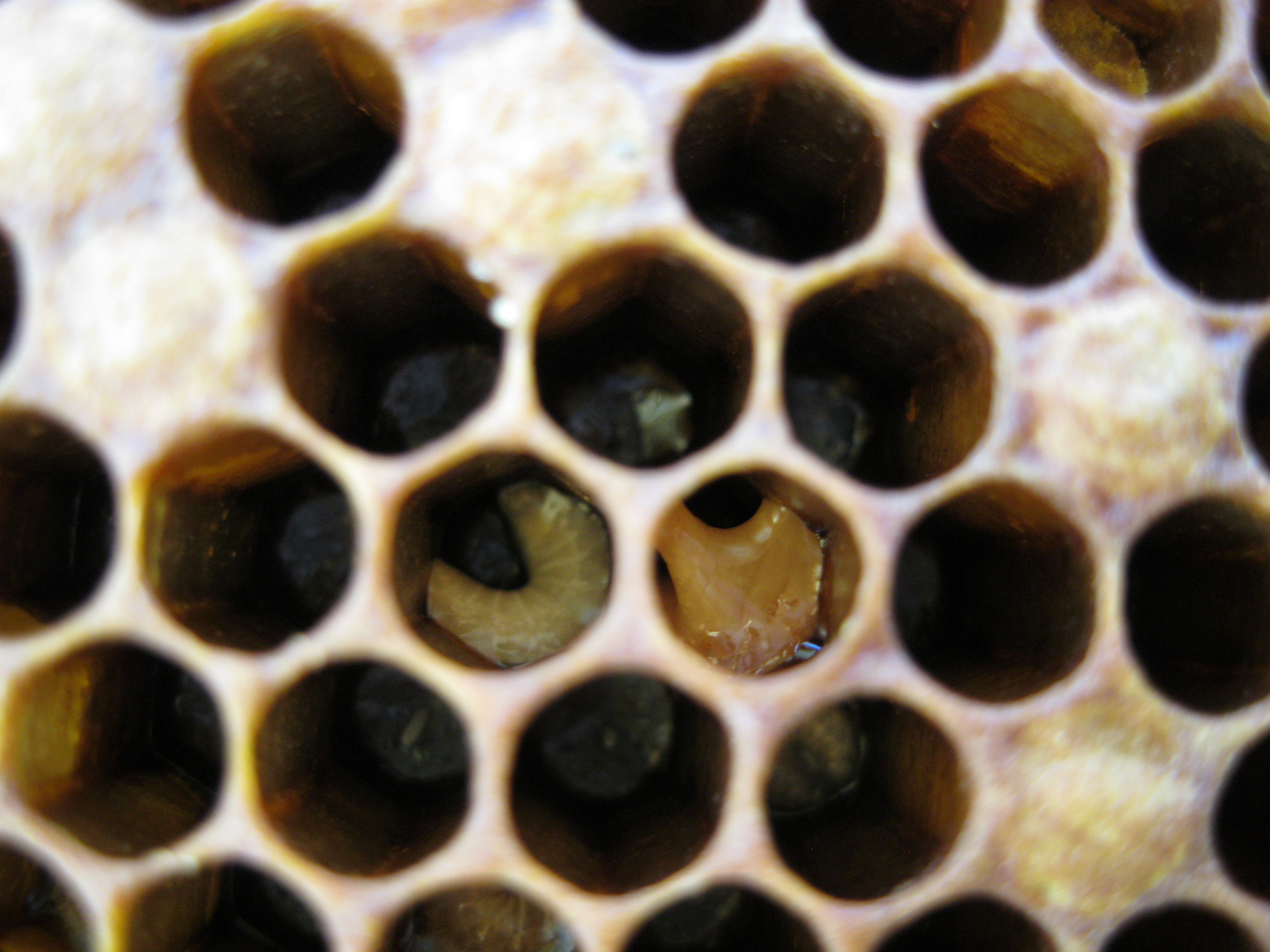
The bacteria multiply in the gut of the honey bee larvae, eventually competing with the larvae for food. Infected larvae often die before capping of the brood cell (3 to 5 days old).
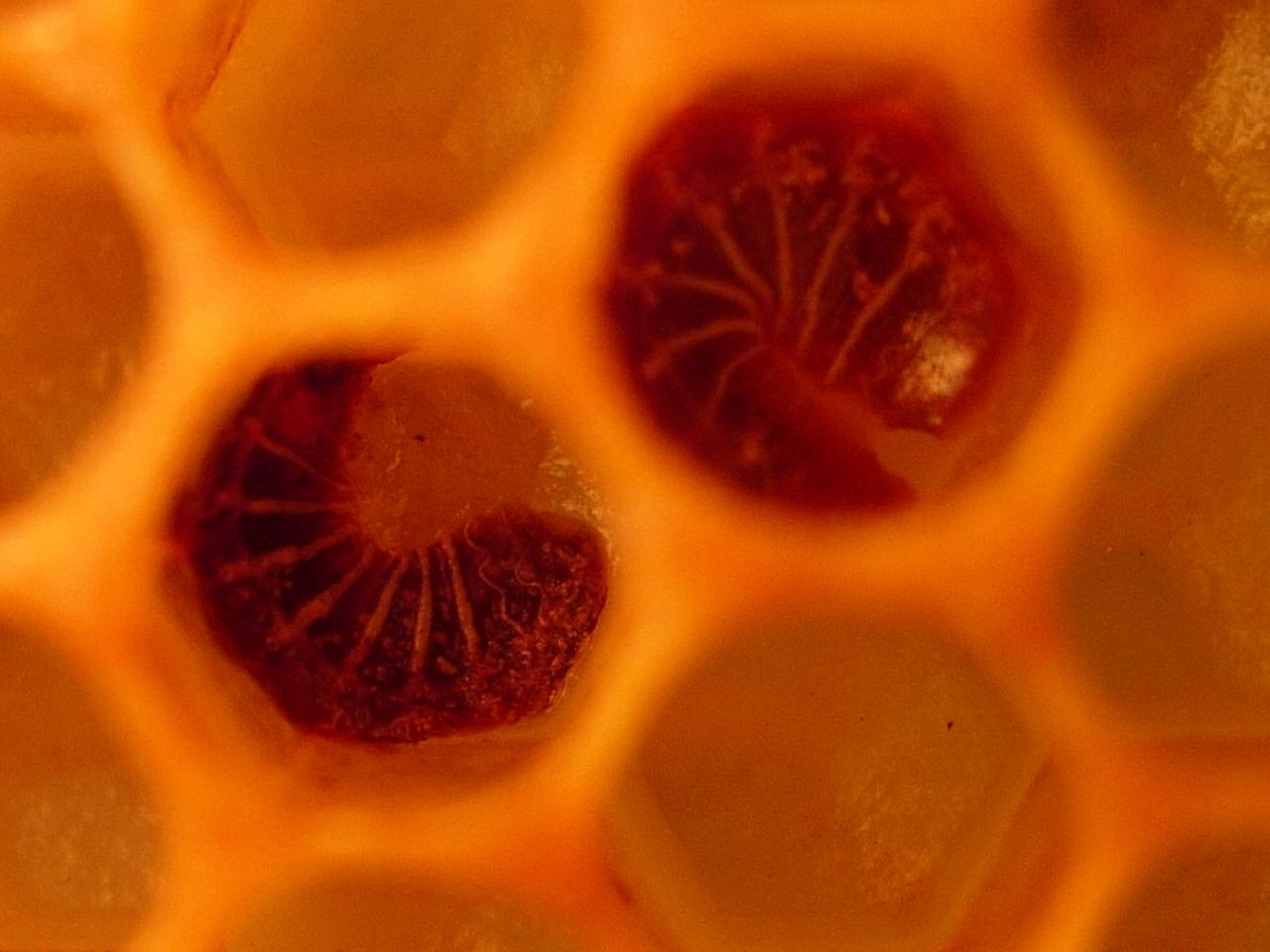
The dead larvae change from a healthy pearl white colour to yellow and then to brown. The larvae then become fluid-like before drying out to become a rubbery scale.
Nurse bees remove the dead or dying larvae and contaminate their mouthparts with EFB. The bacteria is inadvertently fed to other developing brood in the colony. The cycle repeats with more honey bee brood being infected with EFB. Some infected larvae may survive to become adults, but will spread the bacteria in their feces resulting in further infection in the colony.
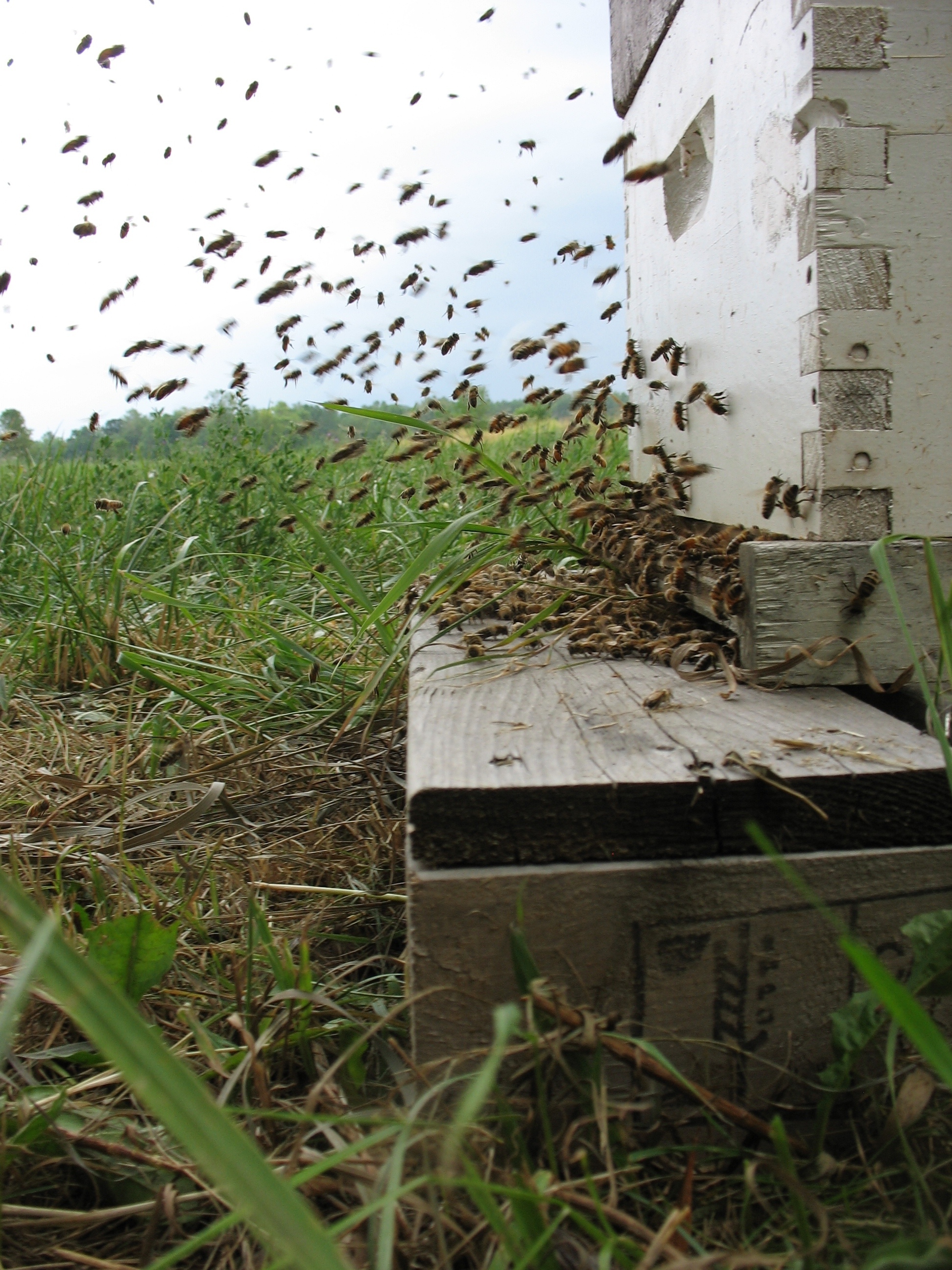
As the colony weakens, it may be targeted by honey bees from different colonies and robbed of its honey stores. As the robbing bees are gathering honey from an infected colony, infective materials (larvae, wax comb) may be encountered by these bees and then the disease is spread to the new colony upon their return.
Signs and symptoms
It is important for beekeepers to familiarize themselves with healthy brood conditions and types of brood disease as all symptoms of EFB are found in the brood nest and used brood comb of the honey bee colony. There are several symptoms that may indicate an EFB infection, but these will vary depending on the stage of infection.
Refer to the quick reference guide to the signs and symptoms of honey bee brood diseases.
Abnormal shape and discoloured larvae
Healthy larvae are always pearl white (Figure 1). Anytime a larva dies in the cell it becomes discoloured and darkens. Having some larvae death in a colony can be normal, therefore seeing discoloured larvae is not always specific to EFB. Brood infected with EFB will turn from white, to yellow, and eventually become brown in colour.
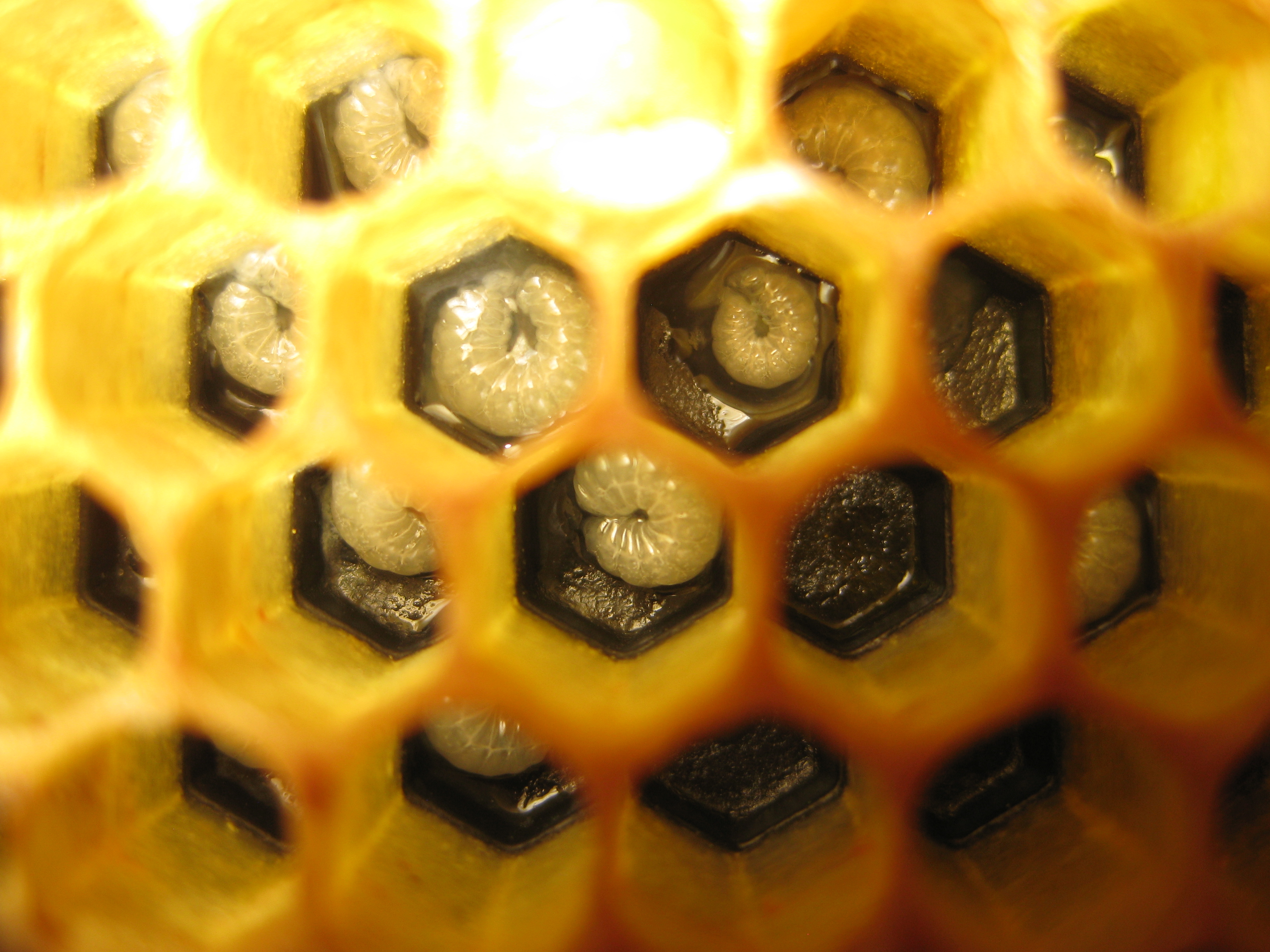
The midgut of larvae infected with EFB may be chalky white, as opposed to a healthy midgut, which would be yellow-orange. As well, the trachea (breathing tubes) can appear noticeably white as the EFB infected larvae darkens in the larval stage (Figure 2).

Infected larvae may also appear to be twisted or stretched in the cell (Figure 3), unlike the traditional “c” shape of a healthy larvae (Figure 1).

Watery, rubbery or dehydrated scale that adheres to the wall of the wax cell
Depending on the stage of the infection, the physical consistency of EFB infected larvae may vary from melted to watery to rotten or become a rubbery or dehydrated scale that lightly adheres to the wall of the wax cell and can be easily removed from the frame (Figure 4).

Sour smell
Honey bee diseases and issues may be associated with an odour (for example, American foulbrood (AFB) can have a distinct fishy or rotten smell). In some cases of EFB, a sour odour may be noticed. This attribute may be somewhat subjective as there are some people who can readily detect and identify the smell where others cannot.
Spotty brood pattern
A healthy, productive colony will produce a solid brood pattern with few empty cells, whereas unhealthy or diseased colonies may have a brood pattern with many missed cells (Figure 5). This characteristic is not always specific to EFB since a spotty brood pattern is common to many colony issues including other brood diseases or a poor or weak queen.
Watery or ropey dead larvae
EFB-infected larvae will have a slightly watery consistency (Figure 6) or become gooey and may stretch out of the cell to a length of 1.5 centimetres or less. This is distinguishable from AFB, which will rope out of a cell to a length of 2.5 centimetres or more. While these characteristics may help distinguish between EFB and AFB, these symptoms are dependent on the stage of the infection and will not always be present earlier or later in the infection cycle.
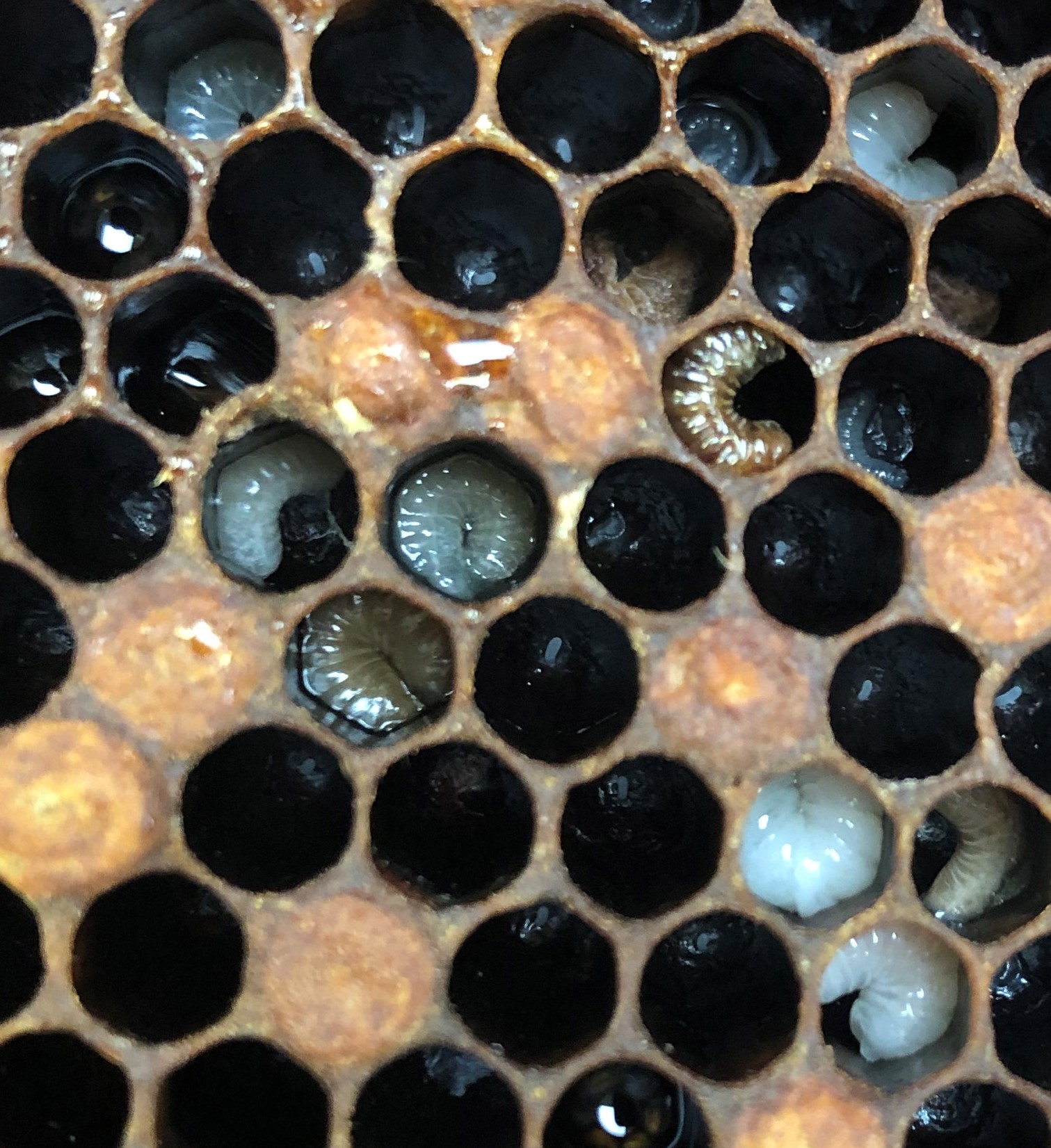
Quick reference guide to the signs and symptoms of honey bee brood diseases
Note: Several of the signs and symptoms of brood disease will vary depending on the stage of infection. Refer to the signs and symptoms section for more information on EFB-specific characteristics.
| Sign/symptom | Healthy brood | American foulbrood | European foulbrood | Chalkbrood | Sacbrood |
|---|---|---|---|---|---|
| Brood cell cappings (wax layer covering the cell) | Slightly convex and light brown in colour Typically no perforations, but noting that right before a brood cell is fully capped the center of the capping may have a small hole in it as the nurse bees are sealing the larvae for completion of it’s development | Slightly concave or could have a dark, greasy appearance Perforations are irregular and are located at the margin of the cappings | N/A - brood cells not capped | Perforations are irregular and are located at the margin of the cappings | N/A - brood cells not capped |
| Brood pattern | Solid brood pattern with few empty cells | Spotty brood pattern with many missed cells | Spotty brood pattern with many missed cells | Spotty brood pattern with many missed cells | Spotty brood pattern with few missed cells |
| Larvae colour | Overall Larvae: pearl white Midgut of the Larvae: visible yellow-orange line running the length of the body | Larvae turns beige, to light coffee brown, to dark coffee brown, then to black as it dries out | Larvae starts off yellow and eventually turns brown Midgut may be chalky white Trachea (breathing tubes) can appear noticeably white | Either black or white | Light tan to dark brown |
| Larvae shape and location | “C”-shape at the end of the cell Upright and stretched out when about to pupate immediately before the cell is to be capped | Dead larvae will settle to the bottom of the brood cell | Dead larvae appears twisted or stretched at the end of the brood cell | May be deposited on the bottom board or near the entrance of the colony | Sometimes the front of the larvae will be upright and protrude from the open brood cell |
| Dead larvae consistency | If punctured, the contents of the cell are watery or aqueous | Gooey, mucus-like consistency in early stages of infection Dry, hard, and brittle in older stages of infection | Gooey, “melted” or watery consistency in early stages of infection Dry and/or rubbery in older stages of infection | Hard and brittle (“mummies”) and rattle in the brood cells | Dark sacs of fluid that have a tough leathery exterior Larvae can usually be removed from the cell in one piece and will often retain the liquid sac formation |
| Ropey test | Does not rope (stretch) out | Can stretch out of the cell to a length of 2.5 centimetres or more | Does not typically rope out May stretch out of the cell to a length of 1.5 centimetres or less | Does not rope (stretch) out | Does not rope (stretch) out |
| Scale | No scale | Black, flat, charcoal-like material that is hard, brittle and cannot be removed from the wax cell without damaging it | Rubbery or dehydrated scale that lightly adheres to the wall of the wax cell and can be easily removed from the frame | Hard, brittle, and chalk-like and will easily fall out of cells without cappings | No scale |
| Smell (subjective as some people cannot smell AFB or EFB odours) | No odour | Fishy or rotten smell | Sour smell | No odour | No odour |
Prevalence and spread
While EFB is most commonly found in early spring, it may appear at any time of the year in honey bee colonies. Since EFB is highly contagious, it can spread to neighbouring apiaries if not well-managed.
Spread of EFB through honey bee activity
Drifting
EFB can spread within a bee yard when honey bees from an infected colony mistakenly enter another colony after returning home from foraging.
Robbing
Robbing occurs when honey bees from one colony collect or rob the honey stores of another colony. It is a natural behaviour of honey bees. In extreme circumstances, where there is a shortage of nectar or weak and/or dead colonies in the surrounding environment, robbing can become quite intense. Robbing can result in the spread of EFB within a bee yard or between different bee yards (up to 8 kilometres away). Robbing is particularly a concern during a nectar shortage.
Spread of EFB through beekeeper activity
Exchanging equipment between colonies
Moving frames of brood between different colonies in a bee yard to equalize colonies or to boost weak colonies is a common and necessary beekeeping practice. However, EFB may be spread from an infected colony to an uninfected colony when this is done. Beekeepers must be mindful of this practice's risk and should be vigilant for any signs and symptoms of the disease.
Packages
Although not likely to spread EFB, honey bee packages from outside Ontario are a potential source of infection. Packages therefore require a federal and/or provincial import permit.
Purchasing honey bee colonies or equipment
Selling and purchasing honey bees or used equipment is a common practice in the beekeeping industry. This practice does risk introducing EFB into an operation. It is important that selling beekeepers are diligent in examining the brood of their colonies to detect EFB. It is equally important that purchasing beekeepers purchase from permitted sources. Selling beekeepers must have a valid permit issued by the Ministry of Agriculture, Food and Agribusiness’ (OMAFA) Apiary Program prior to any sales of bees or used equipment taking place. Permits are issued by the ministry’s Apiary Program only after inspection requirements are met, which helps protect the health of honey bees, particularly from pests and diseases.
Swarms
Swarms may be a source of EFB if the swarm originated from an infected colony. Swarms always pose a risk of transferring pests and diseases since there is no way to be certain of the swarm's origin. However, since a swarm has no brood there is an opportunity to take management steps to minimize EFB risk.
Used beekeeping equipment
Beekeeping equipment that is not properly stored and is in a location accessible to honey bees is a possible source of infection (though the duration of infection is not fully understood on equipment). In most cases, the beekeeper may not be aware the equipment is infected.
Mitigate an infection or outbreak
Beekeepers can take steps to mitigate an EFB infection from establishing itself in their beekeeping operation.
A number of management activities influence the health, production and population of honey bee colonies. Management practices can and will vary depending on the focus of the beekeeping operation (such as honey production, queen and nucleus production, and pollination), but should incorporate basic biosecurity and Essential practices for beekeepers in Ontario (best management practices or BMPs). Good biosecurity practices and basic colony BMPs have been found to be the most effective and practical means of mitigating EFB infections and include:
- familiarizing yourself with the symptoms of EFB and other pathogens of honey bees
- examining your colonies regularly to ensure that they are healthy and disease free, keeping an eye out for the symptoms of brood diseases
- conducting a thorough examination of the brood nest for brood diseases throughout the beekeeping season, with particular attention in spring and fall, and before treatment with drugs (such as oxytetracycline for AFB) which can mask some symptoms of the disease
- properly store used beekeeping equipment, promptly manage dead colonies in a bee yard, and have equipment inspected before a sale or transfer of ownership
Refer to general best management and biosecurity practices for Ontario beekeepers.
Treatment
Antibiotics may resolve an active EFB infection in a colony but are not a guarantee that the infection will end. Beekeepers should be aware that EFB infections can still take place even when antibiotics have been used. Antibiotics are not a replacement for the removal and destruction of infected materials or proper biosecurity practices.
Beekeepers require a prescription from a veterinarian to access antibiotics for their honey bees. For general information on antimicrobial use in agriculture visit the Antimicrobial resistance in agriculture webpage. For more specific information on antibiotics for beekeeping in Ontario refer to the Ontario Beekeepers’ Association’s Antibiotic Access Resources for Beekeepers.
Consult the Treatment options for honey bee pests and diseases in Ontario for recommended monitoring methods, treatment methods and timing of treatments for honey bee pests and disease.
If you suspect infection
Finding an EFB infection as early as possible and taking immediate action is critical to prevent its spread within an operation and area.
If signs or symptoms of an EFB infection are observed in a colony (alive or dead), the beekeeper is to immediately contact their local apiary inspector. It is a requirement of the Ontario Bees Act that a beekeeper reports this disease to the ministry’s Apiary Program. An apiary inspector will come to the yard to inspect the colonies. If the apiary inspector observes characteristics of an EFB infection in the yard (in live or dead colonies or in used beekeeping equipment), samples will be taken for laboratory confirmation. Colonies exhibiting EFB characteristics in the yard will be considered a suspect EFB-positive and all colonies will be retained in the yard pending laboratory confirmation.
When colonies are confirmed positive
A bee yard is considered EFB-positive when laboratory results of samples from 1 or more colonies (alive or dead) from that yard are found to be EFB-positive.
A colony is considered EFB-positive if:
- laboratory results of samples from the colony (alive or dead) are found to be EFB-positive
- it exhibits EFB infection characteristics and is from a yard where laboratory testing results confirmed EFB
If laboratory results of samples taken confirm EFB, the beekeeper is responsible to examine all the colonies in a positive yard to identify possible additional EFB-infected colonies and report these to the inspector.
The inspector will require the beekeeper to take action(s) on the colonies showing EFB infection characteristics in the positive bee yard within a specified timeframe. Beekeepers must, voluntarily or by inspector Order, destroy EFB infected frames.
Treatment of non-symptomatic colonies (this will depend on the time of year and conditions) is recommended and may prevent these colonies from being infected but comes with no guarantees that these colonies will not also develop an EFB infection. Once EFB is present in a yard, regular monitoring by the beekeeper of the other colonies for signs and symptoms of an EFB infection is necessary so they too can be managed in a timely manner to stop the EFB cycle.
In Ontario, OMAFA’s Apiary Program maintains a standard practice that non-symptomatic, live colonies in EFB-positive yards are retained in that yard (that is, not moved from that location), via Retain Order, until an apiary inspector completes a re-inspection a minimum of 7 days (recommended 14 days) after the beekeeper has taken action on all EFB-positive colonies. This is done to allow the beekeeper time to control the infection and allow for re-inspection of colonies in the EFB-positive yard. The Retain Order will be lifted for EFB once no colonies in the yard are found to have visible symptoms of EFB on re-inspection.
Honey supers from non-symptomatic colonies in an EFB-positive yard may leave for extraction, but are to be returned to the same bee yard where they originated. These supers should be labelled and harvested separately from honey supers coming from other uninfected yards in the operation.
Best management and biosecurity practices when infection is found
- Work with an apiary inspector on steps to address EFB where it is confirmed.
- Do not salvage honey from an infected colony.
- Promptly destroy infected frames of bees. Replace destroyed frames with new or used uninfected frames.
- Beekeepers may choose to destroy the entire infected colony and associated equipment (for example, bottom board and other woodenware that cannot be scorched) in the case of serious EFB infections.
- Consider treating EFB symptomatic colonies (after infected frames are removed and destroyed) and all non-symptomatic colonies in the yard with an antibiotic (this will depend on the time of year and conditions).
- Provide sugar syrup (2 sugar:1 water) and pollen patties if colonies appear to be under nutritional stress.
- Monitor the health status of the yard that was infected with EFB on a more frequent basis and be vigilant for EFB in your other bee yards or in the surrounding area.
Destruction of infected materials
Beekeepers must remove and destroy infected frames the EFB-infected colonies.
In serious EFB cases, the beekeeper may choose to destroy full colonies (bees) and associated equipment (hive box, lid, both infected and uninfected frames) to prevent the spread of the disease to other nearby colonies or bee yards.
Where full colonies are voluntarily destroyed, materials to be destroyed include:
- biologicals — all honey bees (larvae, adults), wax comb and the honey crop (honey inside frames).
- equipment — all frames (including brood and honey frames), foundation, honey supers and bottom boards within the colony. The only materials that may be disinfected and not destroyed are hive bodies or boxes, queen excluders (if metal) and telescoping lids.
Salvaging materials or equipment (mainly frames) that are associated with an EFB infected colony increases the likelihood and opportunity that the EFB infection will persist and spread, resulting in more colonies and equipment becoming infected.
How to destroy infected materials
Destruction by fire is the most common method used, and is the method specified in the Bees Act, for destruction infected materials.
Approval for another destruction method may be considered by the Provincial Apiarist in circumstances where there are large amounts of plastic hive equipment (such as full plastic frames versus wooden frames with plastic foundation) or where burn restrictions or fire bans are in place. Contact the Provincial Apiarist in writing if consideration for an alternative destruction or disposal method is sought. Other methods (such as burial or irradiation) must be approved by the Provincial Apiarist.
Whatever the approved method, the beekeeper is ultimately responsible for the destruction of EFB-infected materials when required.
Destroying EFB-infected frames
- Shake bees off of the infected frame(s) back into the colony from which they originated. Note that while adult bees do not present a high risk of carrying EFB bacteria, they can still be a reservoir for the disease.
It is always best to destroy an infected frame as soon as possible as the longer the frame is left in a colony the more the infection may spread, but if frames cannot be immediately removed or destroyed, either:- mark the frame in the colony for identification
- store the infected frame(s) in a completely sealed garbage bag (double bagged and/or a heavy duty bag is recommended)
- Place frame(s) in a hole or metal container and ignite by lighting newspaper or a similar material underneath the frame. Do not add fuel to a wax frame as wax frames are quite flammable on their own.
- Do not place more than a few frames together at the same time (3 or more) when burning. The number of frames to be burned will dictate the size of the burn pit (hole) or container and surrounding conditions (for example, nearby dry grass, trees, buildings) should be considered.
- Ensure that the frames are completely burned.
- Cover the burn pit or hole with soil and ensure that there is no wax, honey or other materials that are attractive to honey bees left exposed. Any material that is left over in a burn barrel must be sealed and managed in a manner where it is not accessible to honey bees.